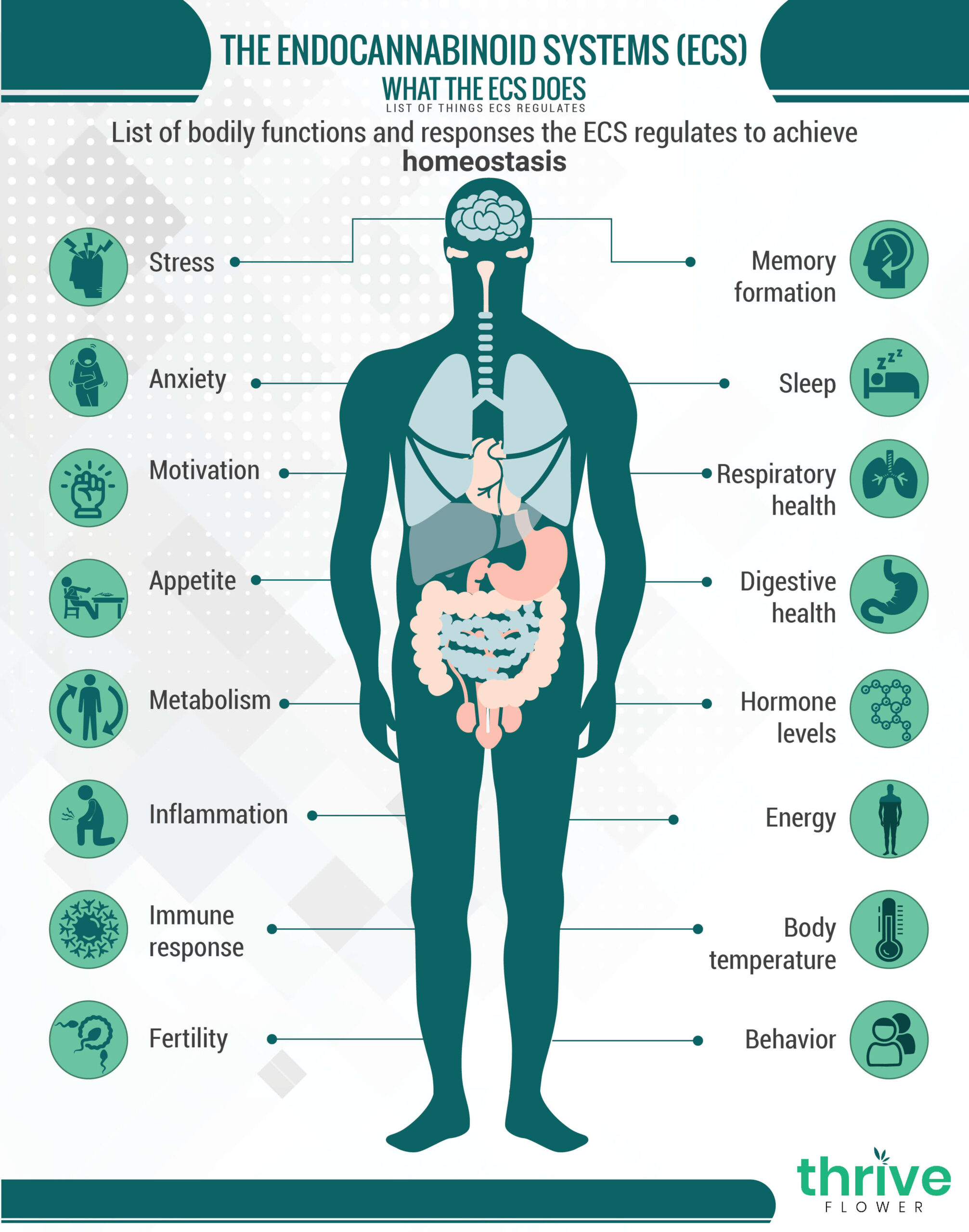The Endocannabinoid System
The endocannabinoid system (ECS) is a bodily system which regulates everything from body temperature to hormone levels and from pleasure to pain. The prefix, endo, comes from the word endogenous which means “naturally-occurring within the body”. A cannabinoid is a molecular compound containing the active molecules of cannabis. So, the ECS is a system of naturally occurring cannabinoids originating from within.
Three parts of the Endocannabinoid System
The Endocannabinoid System is made up of three (3) major parts: endocannabinoids, cannabinoid receptors, and metabolic enzymes. Two main endocannabinoids that form in the body are anandamide and 2-AG. These compounds work as neurotransmitters (chemical messengers to deliver information from cell to cell). Endocannabinoids sit upon and activate cannabinoid receptors.
There are many types of these receptors throughout the body. The two most abundant ones are the CB1 and CB2 receptors. CB1 receptors can be found throughout the central nervous system (in the brain and spine) and CB2 receptors in the peripheral nervous system (outside of the brain and spine). CB1 and CB2 are activated by endocannabinoids, anandamide and 2-AG, to create the ECS bodily response. Phytocannabinoids (cannabinoids from the cannabis plant), such as THC and CBD, also activate with CB1 and CB2.
Once activated, the endocannabinoid system’s receptors begin work to keep the body within a narrow operational range called homeostasis. This could mean cooling you down when you are hot, causing your stomach to rumble so you eat, controlling anxiety, or regulating pain/inflammation. When the task is complete, the final part of the ECS, the metabolic enzymes, breakdown the cannabinoids and deactivate the receptors. The enzyme, FAAH, breaks down anandamide and MAGL breaks down 2-AG.
Homeostasis
The Endocannabinoid System has a singular goal accomplished by many tasks. The goal is homeostasis. Homeostasis in the body is when there is a stable balance between all the interconnected systems that make your body work. This equilibrium is achieved by the interactions of cannabinoids and cannabinoid receptors as well as metabolic enzymes. THC activates CB1 receptors. This is what produces the feeling of being “high”.
Anandamide, another endocannabinoid, also activates CB1 receptors, but, unlike THC, does not make you “high”. This is because the enzyme that breaks down anandamide, FAAH, does not work as well or as quickly on THC. So while anandamide stops working, THC will stick around for quite some time. While CBD does not activate CB1 receptors, it does inhibit the enzyme FAAH which breaks down anandamide (AEA). With this enzyme inhibited, anandamide levels can increase and remain active on the receptor for longer. This could be a reason CBD has been found useful for anxiety relief and pain management.
CBD continued
CBD can also enhance activation other receptors throughout the body. Some receptors include the opioid receptor which regulates pain, the dopamine receptor which has effects on motivation and reward-seeking behavior, and the serotonin receptor (1A) which could be helpful against substance dependence. A combination of these activate receptors has been found to reduce drug cravings in addicts.
Other drugs on the market which are supposed to treat anxiety, depression, and/or addictive tendencies, block the reabsorption of serotonin into the brain so that the serotonin levels increase. This allows the brain cells to transmit a larger quantity of stronger signals. CBD has been found to potentially be a boost for the serotonin signaling through the 1A receptor, doing the job of pharmaceuticals in a natural way.
Summing it up
Cannabinoids, cannabinoid receptors, and metabolic enzymes make up the endocannabinoid system (ECS). Phytocannabinoids such as THC and CBD come from the cannabis plant (mariuana or hemp) and endocannabinoids such as 2-AG and AEA (anandamide) originate within the body. Cannabinoids activate cannabinoid receptors which perform a large variety of tasks in order to accomplish one goal, homeostasis. Once the body is operating healthily and in tune, metabolic enzymes such as FAAH and MAGL breakdown cannabinoids and deactivate cannabinoid receptors.





